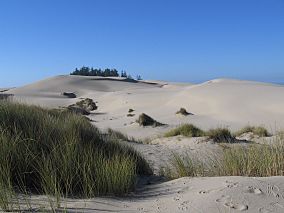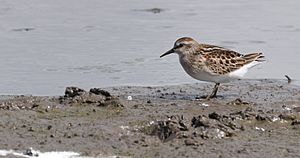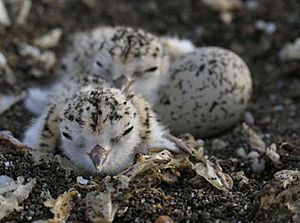Oregon Dunes National Recreation Area facts for kids
Quick facts for kids Oregon Dunes National Recreation Area |
|
|---|---|

Dunes outside Reedsport
|
|
| Location | Oregon, United States |
| Nearest city | North Bend, Oregon |
| Area | 31,566 acres (127.74 km2) |
| Established | March 23, 1972 |
| Visitors | roughly 1,500,000 (in 2005) |
| Governing body | United States Forest Service |
| Website | Oregon Dunes National Recreation Area |
The Oregon Dunes National Recreation Area is an amazing place on the Oregon Coast. It stretches about 40 miles (64 km) from North Bend to Florence. This special area is part of the Siuslaw National Forest. The United States Forest Service takes care of it.
The Oregon Dunes are a unique area of sand shaped by the wind. They are the biggest coastal sand dunes in North America. Some dunes are as tall as 500 feet (152 m)! That's like a 50-story building. These dunes formed over millions of years from wind and rain. About 7,000 acres (28 km2) of the area are covered in sand dunes. You can do many fun things here, like riding off-highway vehicles (OHVs), hiking, fishing, canoeing, horseback riding, and camping. There are even special trails for people with disabilities.
Did you know the famous science-fiction book Dune by Frank Herbert was partly inspired by these very dunes? He loved researching the area!
Contents
History of the Oregon Dunes
The Oregon Dunes are super old, over 100,000 years old! The dunes closest to the ocean started forming about 7,000 years ago. Scientists have studied the sand grains. They found that the sand came from mountains. Rivers like the Umpqua and Siuslaw carried it down to the coast.
It took many years to protect the Oregon Dunes. In 1959, Senator Richard L. Neuberger wanted to make it a national seashore. But some local leaders and groups didn't agree. Later, in 1972, a new law was passed. This law protected 32,186 acres (130.25 km2) as the Oregon Dunes National Recreation Area. This was a big step to keep the dunes safe for everyone.
About one-eighth of the area is private land. The rest, about 27,212 acres (110.12 km2), is owned by the Forest Service.
How the Dunes Were Formed
The sand dunes were shaped by wind and water over a long time. The wind is very important for how the dunes form. In the summer, the wind blows from the north and northwest at 12 to 16 mph (19 to 26 km/h). Mountains near the coast change the wind's path. This helps shape the sand into many different forms.
In the winter, the winds are slower, usually. But during storms, they can reach up to 100 mph (160 km/h)! These strong winds move a lot of sand. This reshapes the dunes. Water also helps form the dunes. Waves and tides bring sand from the ocean floor onto the beaches. Then the wind takes over. The sand is mostly made of quartz and feldspar.
Water currents also create marshy areas. Here, standing water can be several feet deep. Sometimes, sand grains get soaked with water and float. This can create quicksand. You might find quicksand in the low, open areas between the dunes.
The largest lakes in the Oregon Dunes are called barrage lakes. These lakes formed when streams flowing from the Coast Range mountains were blocked by the growing dunes.
Plants and Animals of the Dunes
Plants and Their Importance
Healthy native plants are very important for the dunes' ecosystem. Many native plants are being protected. These include red fescue, Port Orford cedar, evergreen huckleberry, and Sitka spruce.
In the past, people planted non-native plants like European beachgrass and Scotch broom. They did this from 1910 to 1979 to stop the sand from moving. These plants did stabilize the dunes. But they grew too much and now cause problems. They stop the dunes from changing naturally.
Birds and Their Habitats
Many kinds of birds live in the Oregon Dunes National Recreation Area. The South Jetty area has beaches, marshes, and wetlands. Here you might see tundra swan, Canada goose, and least sandpiper.
Along the Siticoos area, near the Waxmyrtle Trail, you can find great blue heron, American bittern, and belted kingfisher. The Eel Creek area has many shore pines. Birds like the pine siskin and Anna's hummingbird find shelter there. In the Horsefalls area, you might spot white-tailed kite, northern harrier, and different kinds of warbler.
Western Snowy Plover: A Success Story
The western snowy plover uses the Oregon Dunes as a nesting site. In 1993, there were only 68 of these birds left in Oregon. The United States Fish and Wildlife Service said they were a threatened species.
Many groups worked together to protect these plovers. They restored the plover's habitat by removing the invasive beach grasses. They also put up signs and restricted beach access during nesting season. This season is from March 15 to September 15. Police officers help enforce these rules. They also removed predators and counted the birds carefully. By 2012, the number of plovers had grown to 403 birds! This shows how much good teamwork can do.
Oregon Dunes Restoration Collaborative
The Oregon Dunes Restoration Collaborative is a group that works to save and restore the dunes. This group started in 2014. They work with many government groups. Their main goal is to stop the spread of invasive plants. These plants take over large parts of the dunes.
As mentioned before, these invasive plants were put there long ago. Land managers wanted to stop the sand from moving. But now, these plants are causing problems. They stop the dunes from forming naturally.
Today, the Collaborative works with the United States Forest Service. They plan how to fix the problem. They also look for money to help. And they teach people about the issues facing the dunes. The group encourages everyone to help. You can volunteer or practice sustainable recreation. This means enjoying the dunes without harming them.
Off-Highway Vehicle Use
The Oregon Dunes National Recreation Area is a very popular place for off-highway vehicle (OHV) use. Before 1979, almost all of the area (91%) was open for OHVs.
In 1994, a new plan changed things. It limited OHV use to only 31% of the total area. This area is split into two large sections. As of 2018, visitors can use the North, Middle, and South OHV riding areas.
-
Jessie M. Honeyman Memorial State Park and part of Cleawox Lake, south of Florence
Images for kids









